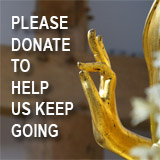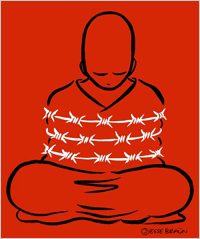
|
|
|
Home Asia Pacific South East Asia Myanmar Myanmar Protest News Monks in HellBy Kyi Wai, Irrawady, October 11, 2007Rangoon, Burma -- “Due to the lack of food and the extreme highs and lows of temperature, some monks and laypeople felt like they were suffocating. Others simply died.
U Sandar Vaya was arrested along with hundreds of other Buddhist monks at midnight on September 26. The Burmese military authorities had started arresting demonstrators that day, detained them in five locations around Rangoonthe Government Technology Institute (GTI) in Insein, the police quarters in Kyaikkasan, and police detention centers in Hmawbi, Thanlyin and Aung Thapyay, according to those people who were later released. One police official estimates that there would have been at least 1,000 monks and laypeople per detention center. U Sandar Waya said he was incarcerated with 500 other monks and 200 civilians in one room of the GTI. The authorities gave them each only one bowl of drinking water in the first two days, later increasing the ration to three bowls. The guards didn't allow the detainees to wash and there was no toilet, only plastic bags for sanitation.
Another Buddhist monk who was recently released confirmed that about 700 monks and laypeople were detained in a hall some 9m by 21m (30 ft x70 ft). “Even though the room could be considered a rather wide area, we were so jam-packed that it was hard to breathe,” he said. The monk, who asked not to be identified, said the guards took each monk in turn from the room and forced him to take off his robe. They were made to put on laymen’s clothes. The authorities provided only one meal per day – a lunch at 2 p.m., which monks can't eat as their Buddhist vow allows them only to eat in the morning. On the concrete floor of the room the guards poured wet sand and, as a result, some detainees became weak and sick very quickly. While in detention, some monks continued to protest against the regime, but many others became too weak to do so. “More than a dozen monks and other people died,” claimed a layman who was released on October 5. “And almost all the detainees got sick. "It really was hell," he said. “I could do nothing for a young novice who was dying beside me. We asked for help from the security guards, but they didn't do anything until they came to take away his dead body.” A 30-year-old man who was released from Kyaikkasan detention center recounted his experience: “At midnight on September 28, the authorities cut off the electricity in the 20 ft by 40 ft (6m x 12m) room where about 200 people, including me, were detained. “Suddenly, they started pumping water into the room while we were sleeping. We panicked. Then the police came running into the room and started beating us. “Wearing wet clothes, we are all taken from the room one by one and interrogated three timesby the police, the Special Branch and the Military Intelligence." The authorities started to release detainees on October 4 on the condition that they would never participate, encourage or even watch any future protest. The conditions for release had to be signed by their parents or guardians. The authorities released those monks who signed the conditions or who weren't suspected of being involved in the protests, but not those monks who refused to sign. As a result, many Buddhist monks are still imprisoned. After release, the monks are not allowed to leave their monasteries. Monks who got injured during the protests still haven’t been afforded medical treatment. It is estimated that more than 3,000 monks and civilians were detained during the demonstrations, and at least 130 people were killed. U Sandar Vaya was released from detention on October 5, but he remains defiant: “They took off my robe, but in my mind I resisted. I am always a monk, whatever they do to me.” |
 Get your Korean Buddhist News here, brought to you by BTN-Buddhist Channel |
 |
 The Mandala app brings together Buddhist wisdom and meditation techniques with the latest insights of psychology and neuroscience to handle the challenges and complexities of modern life. The App offers a series of engaging talks and conversations with experts on a wide variety of topics, such as managing stress, dealing with adversity, developing greater resilience, cultivating empathy and compassion, creating healthy relationships, and many more. These topics are explored to help find greater peace, meaning and joy in our lives. Our panel of experts include Dr, Thupten Jinpa, Daniel Goleman, Kelly McGonigal and others.FREE DOWNLOAD here |
| Point
your feed reader to this location |
| Submit an Article |
| Write to the Editor |

 “The conditions were terrible. We each had no more than a small patch of cell to sit on,” lamented Burmese monk U Sandar Vaya, looking pale and weak and somewhat older than his 33 years.
“The conditions were terrible. We each had no more than a small patch of cell to sit on,” lamented Burmese monk U Sandar Vaya, looking pale and weak and somewhat older than his 33 years.